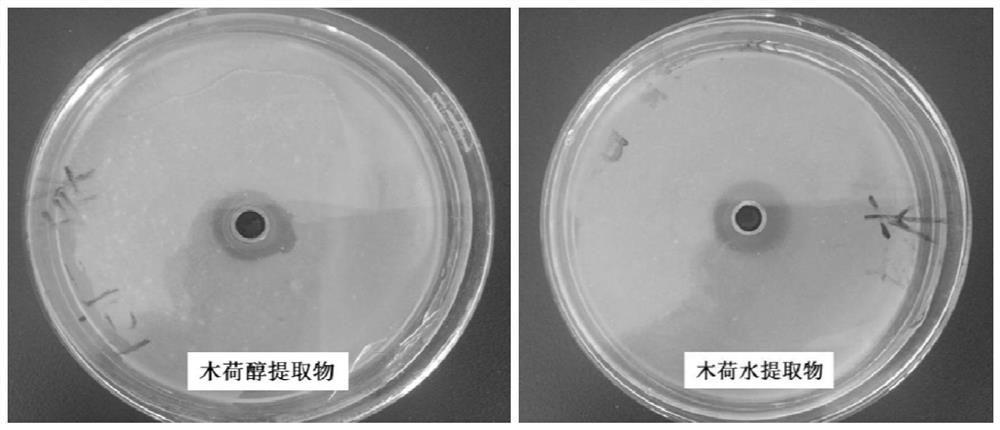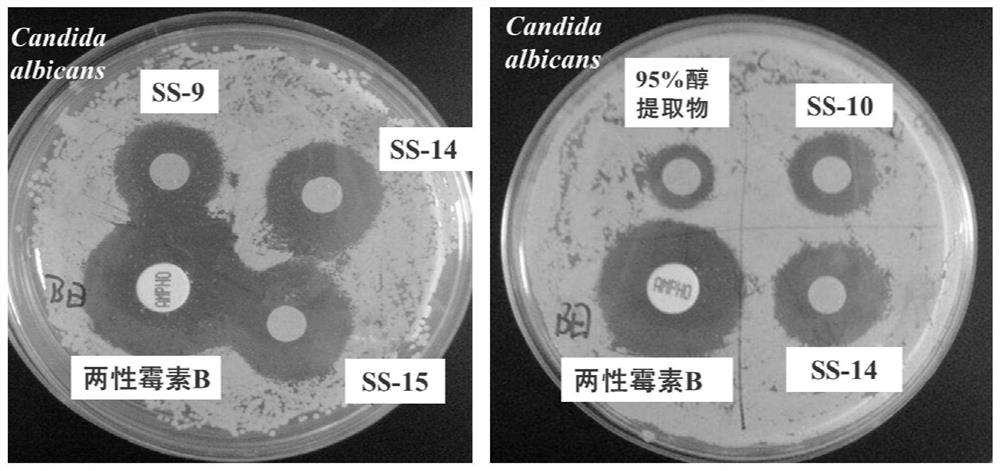A kind of Schima superba extract and its application
A technology of extract and lotus root, applied in the field of lotus root extract, can solve the problem of no antibacterial biological activity of the lotus root extract, and achieve the effect of good antibacterial effect
- Summary
- Abstract
- Description
- Claims
- Application Information
AI Technical Summary
Problems solved by technology
Method used
Image
Examples
Embodiment 1
[0018] In vitro anti-Candida albicans activity test
[0019] In this experiment, the sensitive strains of Candida albicans and the resistant strains of Candida albicans were used as indicator bacteria, and the antibacterial activity of the extracts was determined by the Oxford cup method in vitro drug susceptibility test.
[0020] Wood lotus water extract
[0021] The root bark of the lotus root was properly pulverized, passed through a 40-mesh sieve, and 200 g was taken, and 500 mL of water was added for heating and reflux extraction for 3 times, each time for 1 hour. The extracts were combined and concentrated under reduced pressure to obtain 18.6 g of the extract.
[0022] xylohol extract
[0023] The root bark of the lotus root was properly pulverized, passed through a 40-mesh sieve, 200 g was taken, and 500 mL of 95% ethanol water was added for heating and reflux extraction for 3 times for 1 hour each time. The extracts were combined and concentrated under reduced pressu...
Embodiment 2
[0032] 4.5 kg of dried coarse powder of the stem of the lotus root was heated and refluxed 3 times with 95% ethanol (8 times the amount of medicinal materials) for 2 hours each time, and the extracts of the 3 times were combined and concentrated under reduced pressure to obtain 200 g of total extract.
[0033] The total extract was dissolved and dispersed with 50% methanol water, and extracted with petroleum ether, chloroform, ethyl acetate and n-butanol successively to obtain 50 g of petroleum ether layer, 35 g of chloroform layer, 22 g of ethyl acetate layer, and 20 g of n-butanol. and water layer 45g. The ethyl acetate fraction was subjected to silica gel column chromatography with a chloroform-methanol system (100:0; 90:10; 80:20; 70:30; 60:40; 50:50; 30:70; 0:100) to obtain Fr.1 -20 fractions. The fraction Fr.12 (3.3g) was subjected to ODS reverse column chromatography (180g, 3.5cm x 40cm) water-methanol system (80:20; 70:30; 60:40; 40:60; 20:80; 0 : 100) to obtain frac...
Embodiment 3
[0038] 1. Structural identification of the compound sasanquasaponin III (SS-9)
[0039]
[0040] white amorphous powder, (c 0.30, MeOH). Both Liebermann-Buchard and Molish reactions were positive, and concentrated sulfuric acid-vanillin showed red color (TLC), which was presumed to be triterpenoid saponins. ESI-MS m / z1241.6[M+Na] + , suggesting that the molecular weight may be 1218, combined with 1 H NMR and 13 C NMR spectrum speculates that the molecular formula of compound SS-9 is C 59 H 94 O 26 .
[0041] 1 H NMR spectrum shows 7 angle methyl hydrogen signals [δ H 0.81(3H,s,H-25),1.03(3H,s,H-26),1.08(3H,s,H-29),1.08(3H,s,H-24),1.30(3H,s, H-23), 1.43(3H,s,H-30),1.85(3H,s,H-27)], 1 alkene hydrogen signal (δ H 5.48, br.s), 4 terminal hydrogen signals [δ H 4.92(d,J=7.1Hz,H-1'),5.95(d,J=7.6Hz,H-1"),6.19(d,J=7.0Hz,H-1"') and 6.26(br. s,H-1″′)], a set of characteristic angelica acyl hydrogen signals [δ H 1.88(s,H 3 -5″″′), 2.05(d, J=6.6Hz, H 3 -4""'), 5.86 (...
PUM
 Login to View More
Login to View More Abstract
Description
Claims
Application Information
 Login to View More
Login to View More - R&D
- Intellectual Property
- Life Sciences
- Materials
- Tech Scout
- Unparalleled Data Quality
- Higher Quality Content
- 60% Fewer Hallucinations
Browse by: Latest US Patents, China's latest patents, Technical Efficacy Thesaurus, Application Domain, Technology Topic, Popular Technical Reports.
© 2025 PatSnap. All rights reserved.Legal|Privacy policy|Modern Slavery Act Transparency Statement|Sitemap|About US| Contact US: help@patsnap.com



